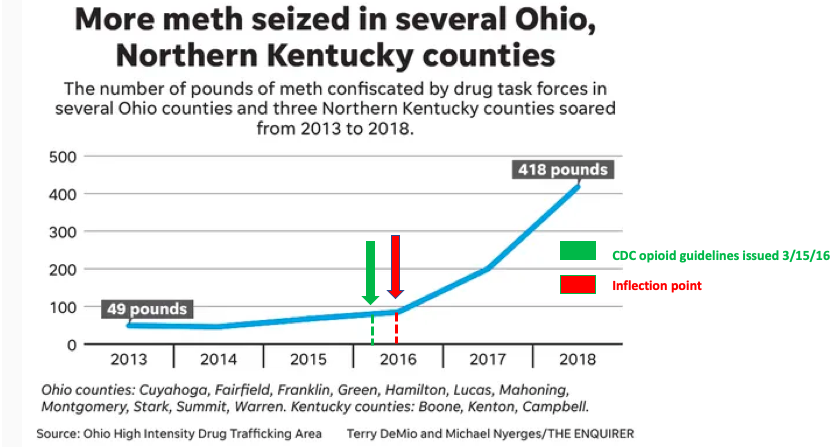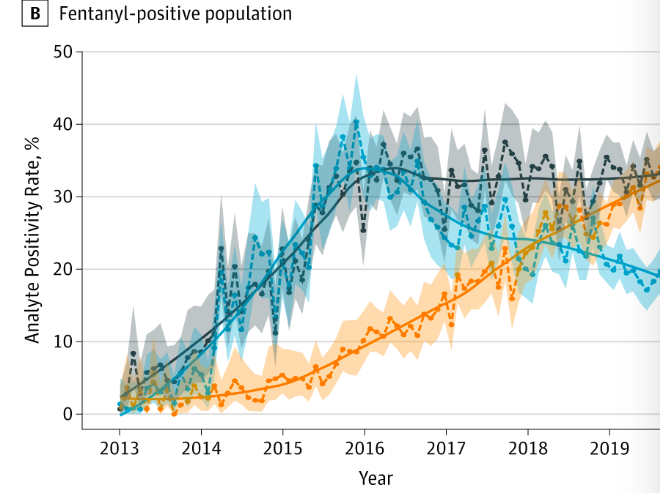"I cut it twice and it's still too short" is an old carpenter's joke about persistence coupled with incompetence. It's a pretty good joke. But there is nothing remotely funny about the persistent incompetents who have caused both suffering and death by adhering to their idiotic plan of combating addiction by strangling the supply of prescription painkillers.
It's now the world's worst-kept secret that the plan has failed on more levels than Super Mario Brothers. But there's always room for "improvement." So let's hear it for PROP, the CDC, and the DEA for helping provide us with two epidemics of two really dangerous drugs – neither of which is medically useful (1) – in place of a far less dangerous class of medicinally necessary medicines. The deadliest drugs in the US right now are fentanyl (no surprise) and methamphetamine and they are now killing far more people per year than oxycodone or hydrocodone ever did. Nice going.
I've written dozens of times how the difficulty of obtaining drugs like Vicodin and Percocet (2) led directly to an enormous surge in heroin use, which created a US market for illicit fentanyl from China beginning in 2013. This is beyond dispute. But, isn't blaming the recent, massive upsurge in methamphetamine deaths on longstanding opioid policies a bit of a stretch? Not really. And I'll go one step further. The fact that meth has come roaring back is the result of two, separate-but-equally-stupid policies, nine years apart.
WHY ARE OPIOID POLICIES CAUSING A SURGE IN METHAMPHETAMINE DEATHS?
A recent story in the Cincinnati Enquirer examined the devastation that methamphetamine has wrought on the Midwest, specifically Ohio and Northern Kentucky. Writer Terry DeMion reported that multiple drug task forces in the two states saw a 1,600% increase in meth seized from 2015 to 2018 (Figure 1).

Figure 1.The amount of methamphetamine (in pounds) seized by 23 task forces in Ohio and Northern Kentucky between 2013-18. I added two block arrows. The green arrow indicates March 2016, when the CDC released its now infamous Guideline for Prescribing Opioids for Chronic Pain. The inflection point, where the slope of the line begins to increase (indicated by the red arrow) occurs three months later. Coincidence? You tell me. Source: Ohio High Intensity Drug Trafficking Areas, the Cincinnati Enquirer.
Whether the two arrows on the chart are actually related is open to debate, but the role of (illicit) fentanyl in bringing back (and then some) methamphetamine is not. Some reasons include:
- Methamphetamine is perceived as a safer alternative to heroin and therefore a much safer alternative to fentanyl.
- Some addicts who are hooked on heroin or fentanyl use methamphetamine as a way to wake up or "come down" from the opioid.
- Both drugs are being increasingly used in combination as measured by urine samples (Figure 2).

Figure 2. Between 2013-19 the percentage of fentanyl users (as determined by urine tests) who also used methamphetamine (orange line) rose from negligible to nearly one-third. The black line represents cocaine and the turquoise line heroin. Source: JAMA Network Open, January 3, 2020.
- In Ohio fentanyl-spiked methamphetamine is becoming much more common as measured by analysis of confiscated samples (Figure 3).

Figure 3. Before 2016, in Ohio fentanyl-spiked methamphetamine was rare. Now almost 3% of seized samples contain fentanyl (blue rectangle). Source: Harm Reduction Ohio
And there's this (emphasis mine):
"They perceive (meth) as different, sometimes even lesser somehow, which is how they underestimate it. But when their batteries are dry, they need to 'come down,' what will they turn to? The opiate-addicted turns to opiates."
Dr. Mina Kalfas, a certified addiction expert in Northern Kentucky. Source: Cincinnati Enquirer
So, it is fair to say that the 2016 CDC Guidelines were directly responsible for the scourge of fentanyl in the US and (at the very least) indirectly for the comeback of methamphetamine use and deaths. The damage from the 2016 PROP-driven CDC guidelines isn't going away. At best, it's morphing.
WHY IS METHAMPHETAMINE SO CHEAP AND EASY TO GET?
This one's easy – another bungling policy. Prior to 2006 (3), most meth was made by a reaction (called a reduction) of pseudoephedrine – the active ingredient in the decongestant Sudafed. This is how the show Breaking Bad began. But the reactions in the pseudoephedrine method give the "chemist" doing the work an impure mess. The yield (the percentage of the amount of material isolated from the reaction divided by the amount expected) is poor so a lot of Sudafed is required.
Enter the DEA (and exit the Sudafed) and the next thing you know chemists came up with another way (called a reductive amination) to make meth. The "new" (4) method was called P2P, which stands for phenyl-2-propanone (aka phenylacetone) – the primary chemical needed for the synthesis. Any organic chemist can tell you how easy it is to perform a reductive amination reaction, so it is not the least bit surprising that methamphetamine became cheaper, purer, and more plentiful than it was before Sudafed got shoved off the counter.
I've written about just this before (See Dear CDC: What Will You Screw Up Next? Meth Is Back). Here's the result of removing Sudafed from the shelves.

Methamphetamine seizures (pounds) in the US 2006-2016. Graph (modified): Sahil Chinoy. N.Y. Times Source: U.S. Customs and Border Protection. The amount of the drug seized surged right after Sudafed was taken off the shelves.
And just in case you need further evidence, how about this? In 2006, the street price of meth across the US was $150/gram and the product was about 40% pure. By 2010 the price had dropped to $50/gram and the purity doubled to about 80% – all a result of the switch to the P2P method of synthesis. More, cheaper and higher quality meth (plus a bunch of runny noses - Sudafed's replacement Sudafed PE is as useful as a goalie mask for a stopping a runny nose). Brilliant.

Let's sum up:
- As opioid pills become less available, partly due to badly misguided efforts to control addiction, heroin becomes the opioid of choice. Sales boom. So do deaths.
- The opioid "problem" becomes a "crisis."
- With a healthy heroin market in place, fentanyl starts showing up from China in 2013. It is easy to synthesize, far more dangerous than heroin, and much easier to transport.
- The "crisis" becomes a "catastrophe" as the worse street drug ever (at that time) replaces heroin or is used to spike it. Deaths soar even though prescriptions of legitimate painkillers decline.
- Fear of fentanyl drives addicts to seek a "safer" alternative – methamphetamine or use it to "detox" from the fentanyl – a sort of "perverse Narcan."
- Methamphetamine deaths soar; it becomes the most deadly drug in certain regions of the US.
- Thanks to the 2006 Patriot Act there is a robust supply of pure, inexpensive meth.
Could we possibly screw this up any worse? That remains to be seen.
Meanwhile, let's thank our elected representatives, state and federal agencies, departments of justice, both state and federal, and the geniuses at PROP (and other academic dilettantes) and their flunkies at the CDC during the early 2010s for helping create a situation that is by any measure worse than a decade ago. I hope they're all sleeping well at night.
Or, if they prefer to stay awake there's plenty of methamphetamine around. That will help.
NOTES:
* Unless otherwise indicated "fentanyl" refers to illicit fentanyl and its analogs, such as carfentanil – not pharmaceutical fentanyl, which is used (in lower doses) for general anesthesia and intractable pain control, often in terminally ill cancer patients.
(1) Both fentanyl and methamphetamine are legal Schedule I pharmaceutical products. What is being sold on the street is not.
(2) To be fair, government cannot be blamed for all of this. Purdue's OxyContin got the ball rolling and when its abuse-resistant formulation was released in 2010 the heroin market took off immediately. After that the anti-opioid movement "picked up the slack."
(3) The Combat Methamphetamine Epidemic Act of 2005, which was part of the Patriot Act was signed into law by President Bush on March 9, 2006.
(4) The P2P method wasn't new. It was used in the past to make meth, but the chemicals needed for the P2P method were beyond the reach of backyard meth labs. Sudafed was an easier starting material until it became controlled. Then the P2P method returned in full force.



